The Intersection Between Geography and Ethnic Culture
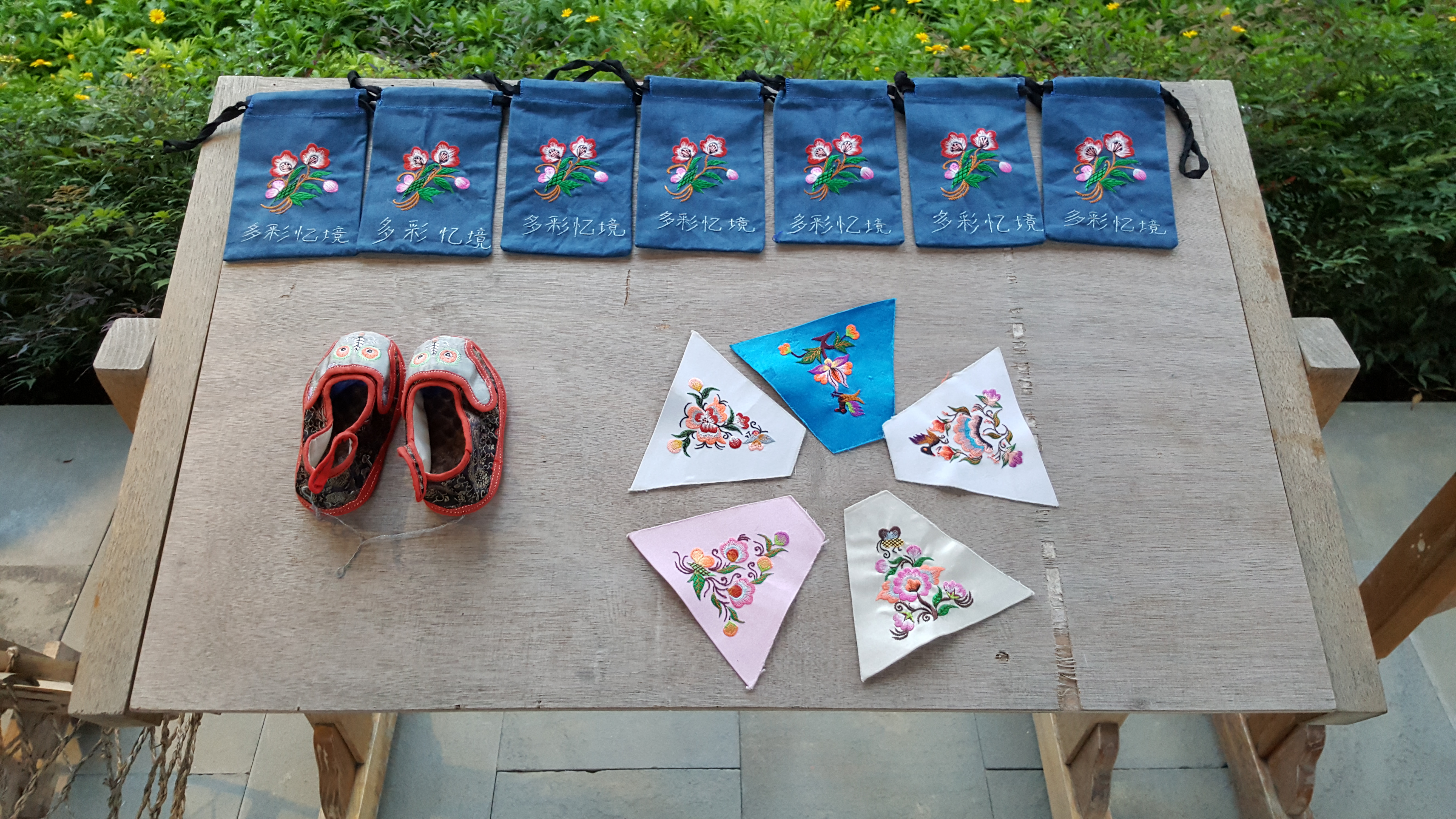
The Mysterious Southwest
China’s southwest region has long fascinated anthropologists and ethnologists as an area of mysteriousness. Rolling mountains and meandering rivers have long isolated the region from the rest of the country, and masked its culture to the outsiders. In fact, the three provinces of the southwest region, namely, Yunnan, Guizhou and Sichuan, are homes to more than 30% of China’s 113.8 million ethnic minority population. These ethnic minority people contribute greatly to the heterogeneity of culture in the southwest.
In recent years, tourism development has taken off in Yunnan and Sichuan, offering more opportunities for us to explore their rich cultural landscapes. On the contrary, as the least developed of the three provinces, Guizhou and its culture remains relatively below the radar of popular attention. Mountains and hills take up over 97% of Guizhou’s territory, holding back the development of its rich natural resources, and keeping its GDP one of the lowest in China. However, it is the same rugged terrain that spares the various ethnic groups in Guizhou from external disturbance, and helps preserve their diverse cultures.
Ethnicity, Geography And Guizhou’s Culture
Ethnicity, or ethnic group, is a key category of differentiation of human communities. As Jon Anderson (2005) puts it, ethnicity can be understood as an identity that emerges when a group shares a common ancestry, origin, and tradition. While it may be related to race, it may also be connected to geographical territory, worldview, custom, ritual, and language. Since each ethnicity has its unique set of culture, a place with more diverse ethnic composition tends to have more diverse cultures.
This is the case for Guizhou, where as many as 48 ethnicities reside in its territory. According to China’s 2010 national census, around 36% of the province’s 34.75 million population is ethnic minority, with a significant share of them from the ethnic groups of Miao (苗族) and Buyi (布依族). They make up as much as 11% of China’s ethnic minority population.
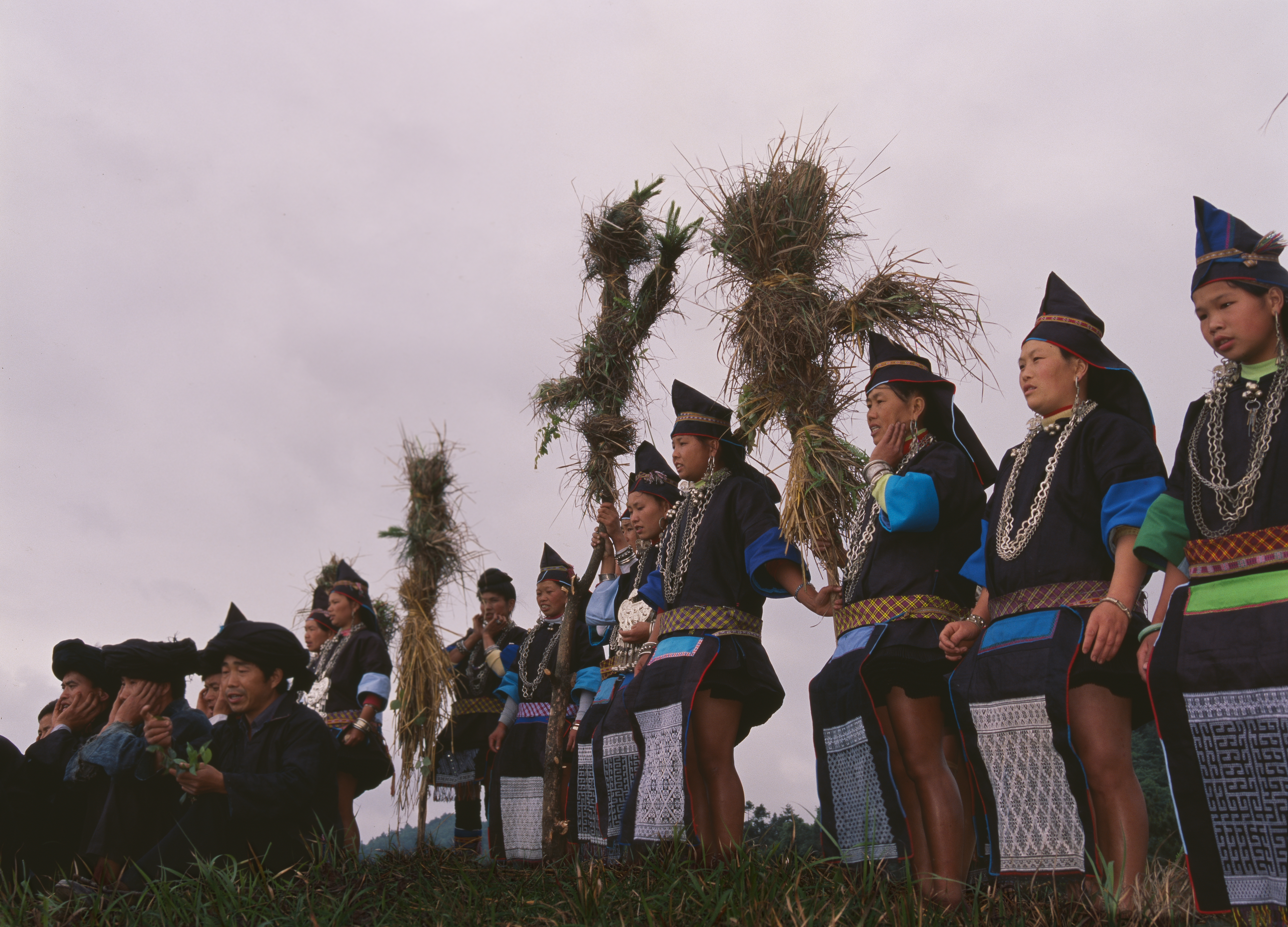
The Miao is a major ethnic minority group in Guizhou (Photo by Lu Xianyi)
Guizhou's geographical context shapes the development of these diverse ethnicities and their culture. Isolated by numerous rivers and mountains, each ethnicity retains a certain degree of territorial independence from each other, and develops its distinct set of values and cultural practices. These ethnicities therefore can co-exist in the province on an equal basis without serious cultural conflict. Neither culture was subordinate to the other and neither culture is dominant. Due to its plurality, Guizhou culture is often called the ‘Thousand Island Culture’ (千島文化).
Guizhou’s Culture: Diverse Yet Connected
Despite its plurality, Guizhou’s culture is not a set of loosely connected subcultures. Beneath the cultural differences between ethnicities lie two shared beliefs. The first one is animism (萬物有靈論), i.e. a belief that objects, places and creatures all possess a distinct spiritual essence. It is the differences in what they worship that distinguish each ethnic groups. This also creates the difference between their rituals. However, though the worshiping objects are diverse, all of them was associated with the lifestyles of the ethnic groups. For instance, for the ethnic groups whose major activity is felling, trees are considered as the object to worship.
Another shared belief of Guizhou’s subcultures is fear. Ancestors of today’s various ethnicities in Guizhou were migrants from central China. The ‘long march’ they had was fraught with difficulties. Some are natural ones, like geological hazards and infectious diseases. Some are human ones, like conflicts with other people along their migration route. Therefore, their rituals usually manifest their fear of death, rivals, disaster, sickness, etc. Fear is the motivation of the nations to protect themselves as well as to develop their cultures.
Traces of Guizhou’s Culture 1: Mountains
Within all the traces, mountains are the most outstanding symbols in Guizhou culture. To Guizhou people, mountains are not merely a natural substance but also are endowed with specific meanings. They are the sites or objects for people to express their particular views on human-nature relations.
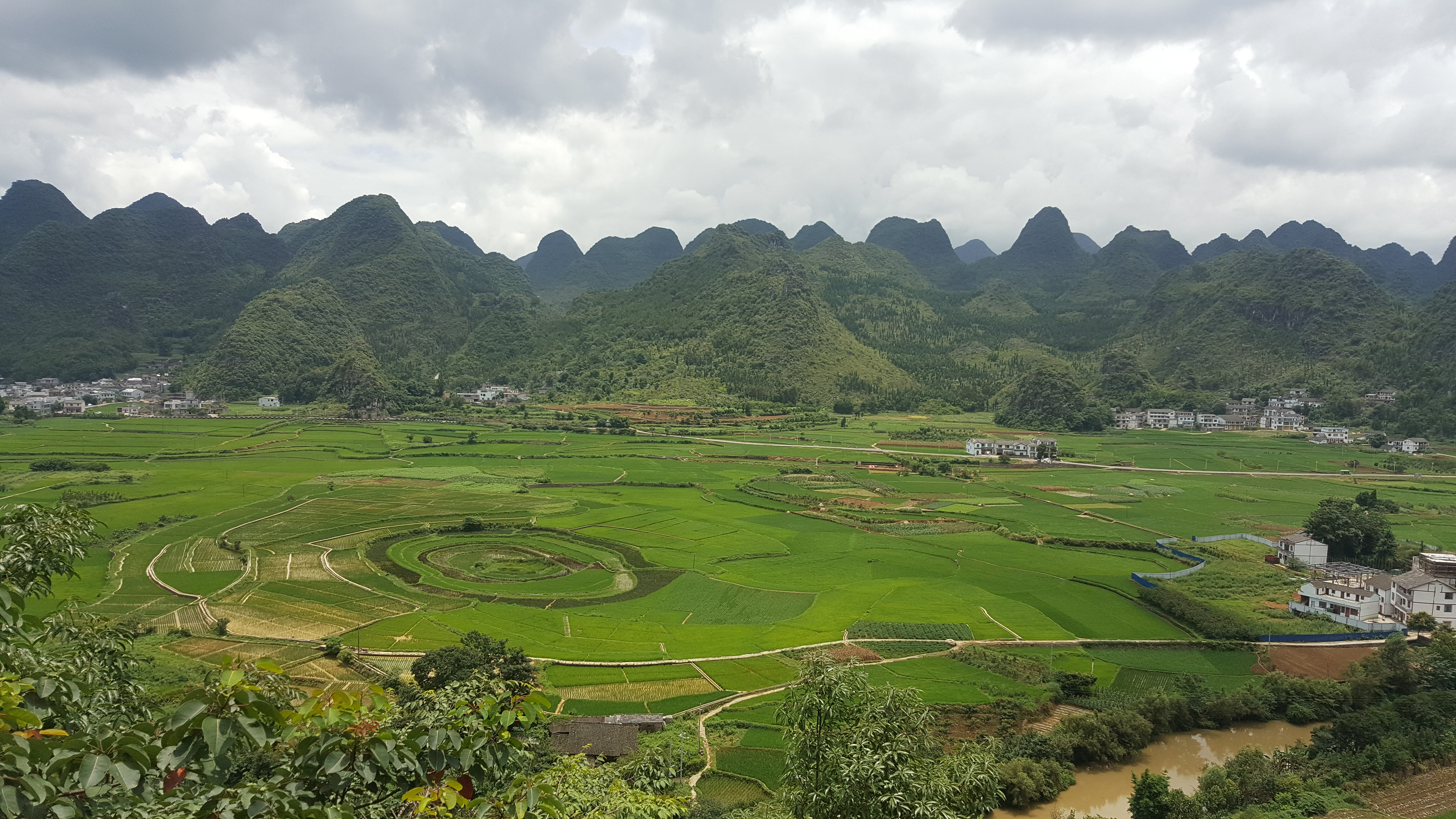
Guizhou is surrounded by mountains (Photo by Calvin Chung)
In fact, mountains have an important role in Guizhou culture because of people’s dependence on mountains for survival. Obtaining natural resources, such as foods and medicine, from mountains, people derived their mode of production and lifestyle from them. Moreover, mountains are also seen as a natural barrier to protect Guizhou people from invasions. As a result, people attach great importance to an intimate harmony between them and nature. This belief demonstrated in the rituals undertaken in the mountains to express their hope, such as worshiping the god of mountains. The linkage between the lives of Guizhou people and the mountains, in fact, represent the relationship between them and nature. Therefore, mountains are more than a natural substance. They are symbols representing saints worshiped Guizhou people.
Trees and house is another pair of traces showing the intimate relationship between people and the natural environment. The diverse mountain living environment creates various mountain communities. Suspended wooden houses are a typical building in Miao villages. Wooden houses are built on stilts a few meters above the ground along the mountain ridge.
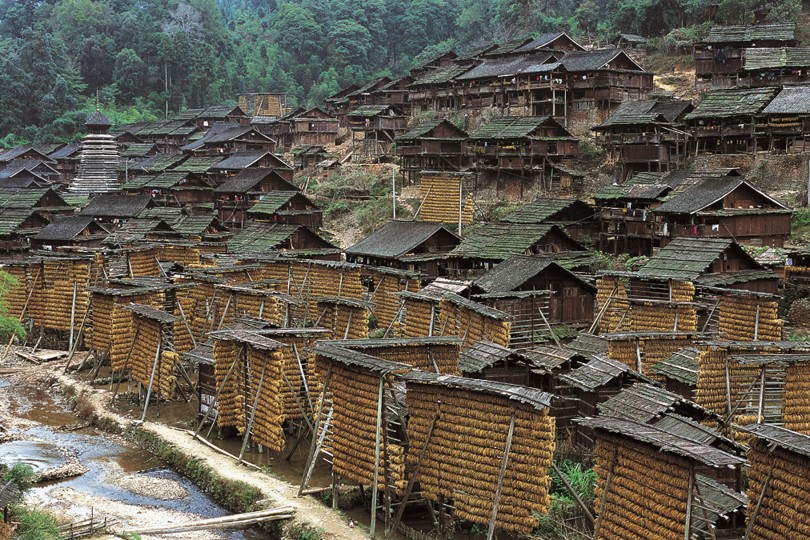
Suspended wooden house embodies the intimate relationship between people and nature in Guizhou (Photo by Lu Xianyi)
Traces of Guizhou’s Culture 2: Silver
Silver represents the trace of costume. Females from the Miao ethnic group in Guizhou would wear heavy and elaborate silver headdresses and jewelry in various ceremonies. Traditionally a Miao woman cannot get married without wearing silver jewelry in her wedding outfit.
Silver takes special importance in Miao culture not only because it is a symbol of wealth. At the very beginning, the ancestors of Miao believed that silvery accessories could exorcise evil spirits and heal the diseases. As Miao was an ethnicity with a history of successive migration, silvers were brought in the journey and used in poison testing.
Today, silvers also symbolize the distinct identity and history of Miao. Lacking their own texts, Miao people used silvery costumes as the carrier of their culture as well as their history. Preserving the traditional silver arts, they serve to survive and transmit tribe culture from one generation to another.
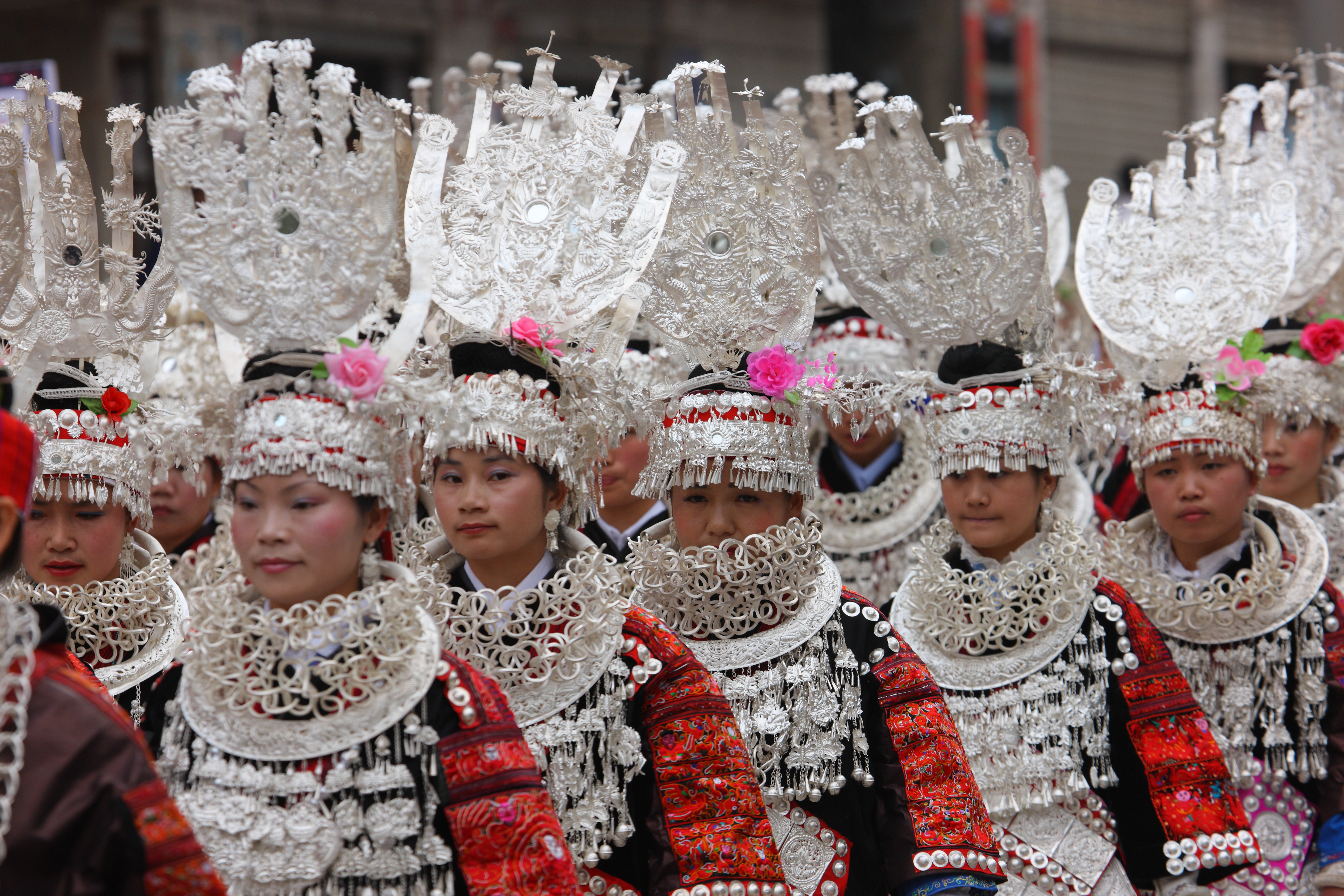
Silvery costumes of the Miao people (Photo by Lu Xianyi)
Trace of Guizhou’s Culture 3: Music and Dances
Just as the case of silver, lacking their own texts, Sheng (笙), songs, and dances the means to transmit their culture. In fact, Sheng is one of the earliest musical instrument in China, which nowadays is still widely used by ethnic folks in Guizhou, especially the Miao. Sheng and drum act as bridges between the present and the past, a media for conversations with the ancestor. Moreover, Sheng also associates with the geographical context of Guizhou. It is believed that in the primitive society, Sheng was used by Miao ancestors to attract their prey.
Singing and dancing are the two most pleasant symbols among ethnic folks in Guizhou. They are integral to the culture of these ethnic folks for thousands of years. As there is no text to help with the passing down of messages, singing and dancing are traces expressing ethnic outlook about the world, embodying the philosophical thinking related to the subsistence, reproduction, and development of the different minorities. In fact, the themes of music and dances in Guizhou are always related to their lifestyle and nature. For example, imitating animals is one of the common themes in dances.

Miao's traditional 'dragon dance' (Photo by Lu Xianyi)
Conclusion
In the case of Guizhou, we can see how culture interacts with geography. On the one hand, the culture of Guizhou is shaped by its environment. On the other hand, its culture also shapes its trace. Isolated by numerous rivers and mountains, diverse cultures were then preserved and manifested in various ceremonies and rituals. In the case of Guizhou, not only can we understand how the geographical context shapes the culture but also how rituals act as significant immaterial traces.
Acknowledgement
We would like to thank Mr. Lu Xianyi for providing us with the precious photos of Guizhou. Without his works, we could hardly present the beauty of Guizhou.
Lu Xianyi was born in 1958 in Guizhou. He changed his major from painting to photography in 1985 and went to Beijing in the early 1990s to work in the field of business portrait photography. Returning to Guizhou, he has been photographing the ethnic group of Black Miao for more than ten years. Lu is a representative of contemporary photographers in China, receiving numerous awards for his outstanding achievement.


